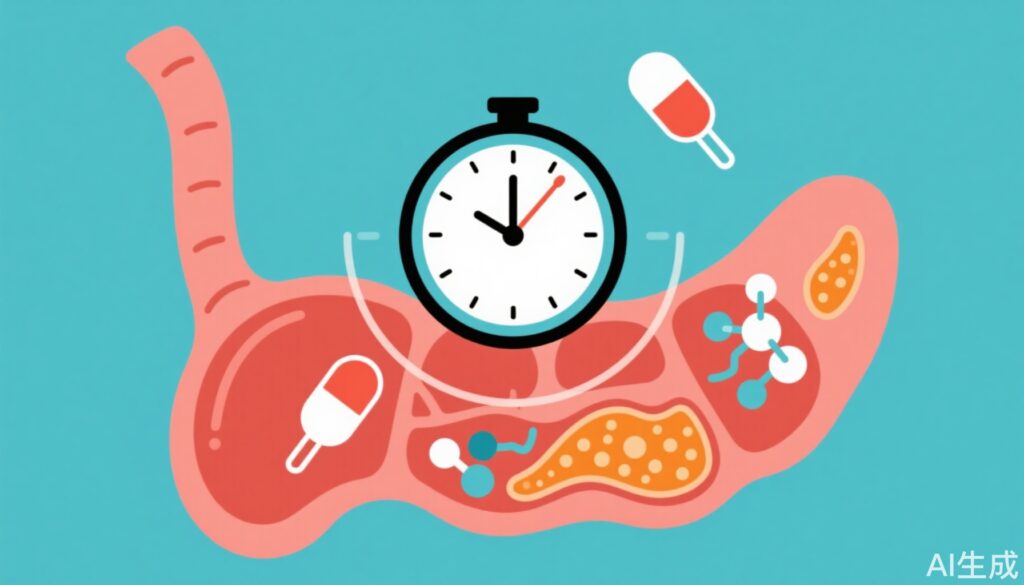Highlights
- Time-restricted eating (TRE) improves pancreatic β-cell function and glycemic control in overweight adults with early type 2 diabetes mellitus (T2DM).
- Short-term TRE reduces hepatic insulin resistance and adiposity but does not significantly alter insulin sensitivity or hepatic glycogen content.
- Systematic evidence shows that intermittent fasting diets, including TRE, produce similar weight loss and cardiometabolic benefits as continuous energy restriction.
- Longer-term studies are needed to clarify sustainability, safety, and clinical endpoints of TRE in diabetes management.
Study Background and Disease Burden
Type 2 diabetes mellitus (T2DM) is a major global health challenge, characterized by progressive β-cell dysfunction, insulin resistance, and increased cardiometabolic risk. Despite advances in pharmacotherapy, lifestyle interventions remain foundational for glycemic control and risk reduction. Among emerging dietary strategies, time-restricted eating (TRE)—limiting caloric intake to a defined daily window (typically 4–10 hours)—has gained attention for potential metabolic benefits, including weight loss, improved insulin action, and cardiovascular risk modification. However, the direct impact of TRE on β-cell function and metabolic parameters in adults with T2DM is not well established, and the optimal regimen (eating window duration, timing) remains unclear. Addressing this knowledge gap may inform nonpharmacologic interventions for early diabetes management.
Study Design
Recent clinical research has explored TRE in T2DM with rigorous, crossover randomized controlled trials (RCTs) and broader systematic reviews:
- Kramer et al. (2025, J Clin Endocrinol Metab): 39 overweight adults with early T2DM (mean diabetes duration 2.9 years; baseline HbA1c 6.6% ± 0.7%; BMI 32.4 ± 5.7) underwent two 6-week intervention periods (TRE: 20h fast/4h eat; vs. standard lifestyle) in random order. The primary endpoint was β-cell function, measured via Insulin Secretion-Sensitivity Index-2 (ISSI-2) during an oral glucose tolerance test. Secondary outcomes included hepatic insulin resistance (HOMA-IR), glycemic control (fasting glucose, HbA1c), anthropometry, and safety.
- Andriessen et al. (2022, Diabetologia): 14 adults with T2DM (BMI 30.5 ± 4.2; HbA1c 6.4 ± 0.7%) were randomized to 3 weeks of TRE (10h eating window) or control (≥14h eating window) in a crossover design. Assessment included hepatic glycogen content (by 13C-MRS), insulin sensitivity (hyperinsulinemic-euglycemic clamp), 24h glucose homeostasis (continuous glucose monitoring), and metabolic substrate oxidation.
- Semnani-Azad et al. (2025, BMJ): A systematic review and network meta-analysis of 99 RCTs (n=6,582, including T2DM and other populations) compared intermittent fasting strategies (alternate day fasting, TRE, whole day fasting), continuous energy restriction, and ad-libitum diets on weight, glycemic, and cardiometabolic outcomes.
Key Findings
Kramer et al. (2025):
- β-Cell Function: TRE resulted in a significant 14% increase in ISSI-2 (mean +14.0 ± 39.2%; P=0.03) compared to standard lifestyle, indicating improved pancreatic β-cell performance relative to insulin sensitivity.
- Insulin Resistance: Hepatic insulin resistance (HOMA-IR) was reduced by 14% (mean -11.6%; P=0.03) with TRE.
- Glycemic Control: While fasting glucose was unchanged, TRE led to a statistically significant reduction in HbA1c (-0.32 ± 0.48%; P<0.001), a clinically relevant improvement in long-term glycemic control.
- Anthropometric Changes: Participants in the TRE arm lost an average of 3.86% of body weight and 3.8 cm in waist circumference, both statistically significant compared to standard lifestyle.
- Safety: No serious adverse events were reported, supporting the feasibility of TRE in this population.
Andriessen et al. (2022):
- Glucose Homeostasis: TRE (10h window) improved 24-hour glucose profiles, increasing time spent in the normoglycemic range (mean +2.9 h/day; P=0.01), and reduced fasting (P=0.03) and mean 24h glucose (P<0.01) compared to control.
- Insulin Sensitivity and Hepatic Glycogen: No significant changes were observed in insulin sensitivity (M value by clamp) or hepatic glycogen content, indicating that short-term TRE may not directly enhance insulin action or hepatic glucose storage in established T2DM.
- Other Metabolic Effects: TRE increased non-oxidative glucose disposal (P=0.04) and reduced 24h glucose oxidation (P=0.04) without affecting overall energy expenditure. No intervention-related adverse events were noted.
Semnani-Azad et al. (2025):
- Weight Loss and Cardiometabolic Outcomes: All intermittent fasting (including TRE), as well as continuous energy restriction, led to weight reduction compared with ad-libitum intake. Alternate day fasting provided a modest additional benefit over TRE and whole day fasting in short-term trials.
- Glycemic Indices: No significant differences were found between intermittent fasting, continuous energy restriction, and ad-libitum diets for HbA1c or HDL cholesterol, suggesting that improvements in glycemic endpoints may be modest or require longer duration for differentiation.
- Lipid Profiles: Alternate day fasting yielded modest reductions in total cholesterol, triglycerides, and non-HDL cholesterol compared with TRE. Conversely, TRE was associated with a slight increase in LDL and non-HDL cholesterol versus whole day fasting.
- Duration Effects: In moderate-to-long-term trials (≥24 weeks), weight loss benefits persisted only when compared to ad-libitum diets, not between fasting strategies or continuous restriction.
| Study | Population | TRE Regimen | Key Metabolic Outcomes | Safety |
|---|---|---|---|---|
| Kramer et al. (2025) | 39 adults, early T2DM | 4h eating/20h fasting, 6 weeks | ↑ β-cell function (ISSI-2); ↓ HOMA-IR; ↓ HbA1c; ↓ weight, waist | No serious AEs |
| Andriessen et al. (2022) | 14 adults, T2DM | 10h eating/14h fasting, 3 weeks | ↑ normoglycemic time; ↓ fasting/24h glucose; no change in insulin sensitivity/glycogen | No AEs |
| Semnani-Azad et al. (2025) | 99 RCTs, mixed | TRE, ADF, WDF | ↓ weight vs ad-libitum; minor cardiometabolic differences among regimens | Consistent safety |
Expert Commentary
The accumulating evidence suggests that TRE is a feasible and generally safe lifestyle intervention for adults with T2DM, with short-term benefits for body weight, glycemic control, and possibly pancreatic β-cell function. However, the magnitude of improvement in insulin sensitivity appears limited, particularly in established diabetes, and the clinical impact on long-term micro- and macrovascular endpoints remains to be demonstrated. Mechanistically, TRE may exert benefits through reduced caloric intake, circadian alignment, and improved metabolic flexibility, but is not a panacea for all metabolic derangements. The absence of significant changes in hepatic glycogen or insulin sensitivity in some studies highlights the complexity of diabetes pathophysiology and the heterogeneity of patient responses. Current guidelines remain cautious, emphasizing individualization and monitoring, particularly in patients on hypoglycemic agents or those at risk for nutritional deficits.
Conclusion
Time-restricted eating offers a promising adjunctive strategy for improving metabolic health and β-cell function in overweight adults with early T2DM. While short-term trials report modest improvements in glycemic control and adiposity, further research is required to establish optimal protocols, long-term efficacy, and safety in diverse patient populations. Clinicians may consider TRE as part of comprehensive diabetes care, with careful patient selection, education, and ongoing monitoring.
References
1. Kramer CK, Zinman B, Feig DS, Retnakaran R. Effect of Time-Restricted Eating on β-Cell Function in Adults With Type 2 Diabetes. J Clin Endocrinol Metab. 2025 May 19;110(6):e2045-e2053. doi: 10.1210/clinem/dgae594. PMID: 39193706.
2. Andriessen C, Fealy CE, Veelen A, et al. Three weeks of time-restricted eating improves glucose homeostasis in adults with type 2 diabetes but does not improve insulin sensitivity: a randomised crossover trial. Diabetologia. 2022 Oct;65(10):1710-1720. doi: 10.1007/s00125-022-05752-z. PMID: 35871650; PMCID: PMC9477920.
3. Semnani-Azad Z, Khan TA, Chiavaroli L, et al. Intermittent fasting strategies and their effects on body weight and other cardiometabolic risk factors: systematic review and network meta-analysis of randomised clinical trials. BMJ. 2025 Jun 18;389:e082007. doi: 10.1136/bmj-2024-082007. PMID: 40533200; PMCID: PMC12175170.



